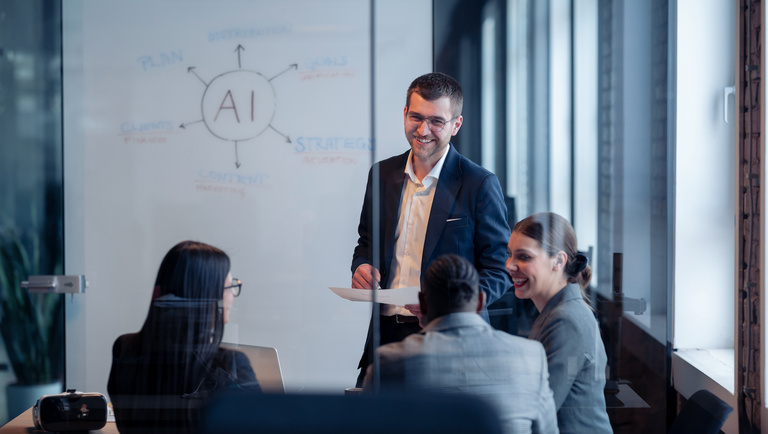
- Blog, Engineering & Production
- Published on: 07.11.2025
- 5:32 min
AI and Humans in Harmony: What the EU AI Act Means for Businesses
Around half of all companies in Europe already use AI modules, and this number is growing rapidly. According to Lufthansa's AI-Ready Enterprise 2024 study, 92% of companies plan to significantly increase their use of AI over the next three years. Many organizations are applying AI in pilot projects for automation, decision support, and HR processes. What was once primarily viewed as a driver of innovation and efficiency is now subject to a new framework. Since August 1, 2024, the first comprehensive legal framework for artificial intelligence in Europe has been in effect.
At its core, the regulation focuses on the intersection between humans and AI. AI offers enormous potential, but it only delivers real value when used responsibly and transparently in alignment with people within an organization. EU AI Act Article 4 addresses this issue by demanding technical safety and emphasizing AI literacy, transparency, and the thoughtful use of AI systems.
Therefore, the key question is not “Which AI tools should we use?” but rather: “How can we develop the necessary skills, structures, and culture to ensure humans and AI collaborate in a compliant, trustworthy, and forward-looking manner?”
The EU AI Act in Practice: Article 4 as the Key to Competence and Culture
The EU AI Act aims to responsibly manage risks and unlock the opportunities of artificial intelligence. For businesses, this requires adaptation in technical, organizational, and cultural aspects. One article stands out in particular: Article 4 of the EU AI Act, which emphasizes the importance of AI literacy.
What does AI literacy mean?
AI literacy refers to the ability to understand artificial intelligence, critically evaluate its results, and use it responsibly. It includes:
A basic understanding of how AI works and where its limits lie
The ability to interpret and reflect on AI-generated results
The capacity to evaluate opportunities and risks within one’s work environment
A sense of responsibility when deploying and monitoring AI systems
For companies, this means:
- Building competencies: Employees must be empowered to understand, evaluate, and confidently use AI systems in their daily work.
- Creating transparency: Decisions made with or by AI systems must be understandable and explainable.
- Ensuring oversight: Humans remain accountable, even when processes are automated through AI.
- Engaging all levels: AI literacy concerns everyone, from operational staff to top management.
The legislative intent is clear: to promote thoughtful and responsible AI use in the spirit of Responsible AI. This approach goes beyond mere compliance by placing transparency, fairness, and human accountability at the heart of human-AI integration.
The Blind Spot in Many Companies: Why AI Implementation Often Fails Due to Culture
Many organizations already have the technical foundations for AI in place. Systems are running, and initial use cases are live. Yet, implementation often stalls. The reason is rarely a lack of technology; it's usually due to a lack of cultural alignment.
Common challenges are easy to identify:
- Overwhelm and Uncertainty: Employees may feel excluded from the process or worry that AI could jeopardize their position.
- Lack of understanding: Without an understanding of how AI works, skepticism can grow, often leading to passive resistance.
- Unprepared leadership: Many managers know they need to guide and demonstrate AI use, yet they still feel insecure in this role.
- Unclear governance and roles: Especially in complex matrix structures, there is often no clear responsibility for AI topics. Without defined ownership, gaps arise between compliance, business units, and IT.
As long as the cultural dimension is overlooked, the EU AI Act will remain more of a compliance exercise than a true transformation. Organizations can only unlock the full potential of human and AI integration when AI literacy and acceptance are embedded in everyday work.
The MHP Approach: Achieving True AI Integration with AI4Human
The EU AI Act makes one thing clear: artificial intelligence is changing roles, responsibilities, and even entire organizational structures. Gains in efficiency through AI can only be sustainable when the roles of AI users evolve alongside the technology and new areas of responsibility are established within the company.
MHP's AI4Human Framework bridges the gap between regulatory compliance and cultural transformation. The goal is to develop an AI strategy and culture in which AI is trusted and accepted as part of daily work.
The implementation is built on three pillars:
- Enablement and AI Literacy: Employees are empowered to understand and use AI responsibly. Before introducing learning formats, MHP conducts a readiness assessment. This assessment determines where the company and its employees currently stand in terms of AI and change readiness. Based on these insights, tailored measures are developed. Through workshops, in-depth training sessions, and interactive learning formats, employees experience firsthand how AI makes decisions and learn to identify opportunities and limitations.
- Leadership and Role Clarity: Leaders take responsibility, act as role models, and actively shape the transformation. They do this by acting as change agents who drive cultural evolution, as early adopters who test AI in everyday work, and share insights, and as sponsors who allocate resources and highlight AI’s strategic value within the organization. MHP supports this by offering coaching sessions that help leaders develop clear stances and define new roles. For example, by introducing dedicated domain owners who take responsibility for specific AI application areas, thereby creating clear accountability.
- Change and Communication: Transparency accompanies transformation, and structures and narratives build trust in AI. Internal communication initiatives, such as newsletters and change stories, highlight the tangible benefits of AI that are already visible today. These initiatives foster understanding and acceptance.
In this way, MHP establishes a connection between AI compliance and AI culture, which is fully aligned with EU AI Act Article 4. The result is faster implementation, greater acceptance, and long-term resilience when it comes to managing the integration of humans and AI within organizations.
Conclusion: Humans Decide the Success of the EU AI Act
The EU AI Act sends a powerful message about the responsible use of artificial intelligence. It goes beyond technical and legal requirements, opening the door to positioning AI as a driver of trust, participation, and sustainable value creation. The most important question is whether companies will view it as merely a regulatory obligation or as a catalyst for genuine cultural transformation.
With AI4Human, MHP shows how this vision can be put into practice. Regulatory requirements are translated into specific actions related to communication, leadership, and skill development. Consequently, the EU AI Act is transformed from a bureaucratic exercise into a catalyst for efficiency, resilience, and innovation.
Organizations that invest early in cultural integration gain a competitive advantage. AI then becomes not a disruptor but a true engine of future readiness and long-term success, fully aligned with the principles of EU AI Act Article 4, AI literacy, and effective human-AI integration.
FAQ
Technical compliance involves adhering to the EU AI Act's formal requirements, including documentation, risk assessments, and control mechanisms. AI culture goes beyond this, ensuring that people within the organization understand, accept, and use the technology responsibly. At the same time, it fulfills the purpose of EU AI Act Article 4, which emphasizes AI literacy and employee empowerment. Only the interplay of both dimensions makes AI truly effective and sustainable.
Yes, the EU AI Act clearly states that AI must be safe, legal, ethical, and socially responsible. With AI4Human, we deliberately integrate these aspects by translating regulatory requirements into communication initiatives, cultural programs, and leadership responsibilities.
To clearly define responsibilities, risks, and decision-making processes for AI, governance structures must be expanded. Many organizations establish an AI Governance Board or Ethics Committee to manage regulatory, ethical, and cultural issues jointly. Whether a dedicated body is necessary depends on the company's size and complexity. However, what is always crucial is a clear organizational framework with well-defined roles.
The EU AI Act explicitly covers the entire value chain. Therefore, companies must ensure that their partners and suppliers adhere to the same standards. This can be accomplished through contractual agreements, risk assessment documentation, or joint audits. Transparent communication and coordinated processes throughout the supply chain are essential for success.
First, a thorough risk assessment determines the risk category of the system and whether it qualifies as a high-risk application. The assessment also examines potential biases and ensures human oversight, as well as the transparency and explainability of outcomes. In addition to technical aspects, the evaluation includes ethical and societal impacts. Proper documentation and continuous monitoring guarantee that risks are managed consistently.
For more details and practical tips, see our article “Understanding and Implementing the EU AI Act: How to Use AI in Compliance with the Law". Read on to explore the topic in depth.
Leaders are key multipliers. They provide guidance, build trust, and demonstrate the thoughtful use of AI. Article 4 of the EU AI Act explicitly requires companies to empower leaders to share knowledge, support employees, and ensure the responsible use of AI. Without clear leadership roles, establishing AI literacy is difficult.
The EU AI Act transforms everyday work by requiring that AI-related processes be more structured and transparent. Decisions supported by AI must be explainable; documentation becomes mandatory; and employees need training to competently use applications. Although this adds new responsibilities, it also fosters greater security, trust, and efficiency.
A human-centered approach puts people at the core. This ensures that AI is viewed as more than just a regulatory obligation; it is also seen as an opportunity for better collaboration, greater innovation, and increased trust in technology. Employees feel included, leaders become more confident in their decisions, and organizations can implement AI more quickly and effectively.
Targeted programs support leaders by combining knowledge, role understanding, and practical application. Through these programs, leaders learn the legal and technical foundations they need to know, how to fulfill their responsibilities as role models and drivers of change, and how to effectively use and communicate AI in their daily work. This approach fosters confidence in working with AI and sets an example of leadership that resonates throughout the organization.



